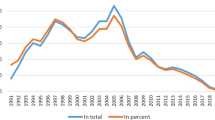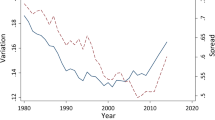Abstract
In this paper two models are developed in an attempt to elucidate the factors that influence the regional distribution of R&D labor across the regions of Greece. The first one is based on an adaptation of the [Guerrero and Seró (1997) Regional Studies 31:381–390] model to the Greek context treating the regional distribution of R&D labor as a function of the extent of agglomeration and the prevailing economic conditions. The second model extends the first one by taking into account two additional factors, viz. the production structure and infrastructure. The econometric results indicate the superior performance of the extended model in the context of Greece as well as attribute the location of R&D labor mainly on the diversification of industrial activity and the number of establishments in innovation-intensive sectors. It is therefore suggested that the stimulation of the regional production structure and infrastructure is essential for ‘knowledge-lagging’ regions.



Similar content being viewed by others
Notes
For a review of such approaches see Chisholm (1991).
For a more detailed survey see Fine (2000).
Data on R&D expenditures do not cover all administrative divisions of Greece or the entire time period.
According to the latest Standard Industrial Classification (SIC) system of the NSAG, established in 1991, the R&D sector corresponds to the two-digit SIC code 73.
The analysis covers the period 1970–2000 as the NSAG conducts its industrial census approximately every ten years and thus data after 2000 are not available from a reliable source.
Prefecture R9 is the ‘leading region’ of Greece with 40% of the population, 50% of industrial activity and the highest GDP, contributes around 38% to the total national output.
The NSAG provides data on GVA for the 1970 to 2000 period, deflated at 1970 current prices. Ideally, the data should have been deflated using regional price deflators. Unfortunately, as regional price indexes are not available from any official source, national deflators were used.
It is worthy informing here that Capello (2002) also reported similar findings for the case of Italy; and in particular for the localization and urbanization economies’ high spatial concentration, viz. of the high-tech sector in the metropolitan area of Milan.
As a rule of thumb, the best fitting model is the one that yields the minimum values for the AIC or the SBC criterion, calculated as \(AIC = T\ln {\left( {RSS} \right)} + 2n\) and \(SBC = T\ln {\left( {RSS} \right)} + n\ln {\left( T \right)}\), where RSS is the residual sum of squares, T is the number of observations and n stands for the number of parameters estimated. The SBC test has superior properties and is asymptotically consistent, whereas the AIC is biased towards selecting an overparameterized model (Enders 1995).
References
Acs Z, Audretsch D, Feldman M (1994) R&D spillovers and recipient firm size. Rev Econ Stat 76:336–340
Alexiadis S, Tomkins J (2004) Convergence-clubs in the regions of Greece. Appl Econ Lett 11:387–391
Boldrin M, Canova F (2001) Inequality and convergence in Europe’s regions: reconsidering European regional policies. Econ Policy 32:207–253
Button K, Pentecost E (1999) Regional economic performance within the European union. Edward Elgar, Cheltenham
Capello R (2002) Entrepreneurship and spatial externalities: theory and measurement. Ann Reg Sci 36:387–402
Chisholm M (1991) Regions in recession and resurgence. Unwin Hyman, London
Christopoulos D, Tsionas E (2004) Convergence and regional productivity differences: evidence from Greek prefectures. Ann Reg Sci 38:387–396
Coffey W, Bailly A (1996) Economic restructuring: a conceptual framework. In: Lever W, Bailly A (eds) The spatial impact of economic changes in Europe. Aldershot, Avebury
Enders W (1995) Applied econometric time series. Wiley, Chichester
Fagerberg J (1996) Technology and competitiveness. Oxf Rev Econ Policy 12:39–51
Fischer M, Varga A (2003) Spatial knowledge spillovers and university research: evidence from Austria. Ann Reg Sci 37:303–322
Fine B (2000) Endogenous growth theory: a critical assessment. Camb J Econ 24:245–265
Green W (1997) Econometric analysis. Prentice-Hall, London
Guerrero D, Seró M (1997) Spatial distribution of patents in Spain: determining factors and consequences on regional development. Reg Stud 31:381–390
Henderson V (1997) Externalities and industrial development. J Urban Econ 42:449–470
Hurst C, Thisse J, Vanhoudt P (2000) What diagnosis for Europe’s ailing regions? European Investment Bank Papers 5:9–29
Jaffe A (1986) Technological opportunity and spillovers of R&D: evidence from company patents. Profits and market value. Am Econ Rev 76:984–1001
Jaffe A (1989) Real effects of academic research. Am Econ Rev 79:957–970
Jaffe A, Trujtenberg M, Henderson R (1993) Geographic localisation of knowledge spillovers as evidenced by patent citations. Q J Econ 108:577–598
Kim T, Knaap G (2001) The spatial dispersion of economic activities and development trends in China: 1952–1985. Ann Reg Sci 35:39–57
Korres G, Rigas K (2002) Research and development, statistical measurement and the regional dimension of innovative activities. National Statistical Institute of Greece, Athens
Lucas R (1988) On the mechanisms of economic development. J Monet Econ 22:3–42
Lucio J, Herce J, Goicolea A (2002) The effects of externalities on productivity growth in Spanish industry. Reg Sci Urban Econ 32:241–258
Maskell P, Malmberg A (1999) Localised learning and industrial competitiveness. Camb J Econ 23:167–185
Moucque D (2000) A survey of socio-economic disparities between the regions of the EU. European Investment Bank Papers 5:13–24
Oakey R, Thwaites A, Nash P (1980) The regional distribution of innovative manufacturing establishments in Britain. Reg Stud 44:235–253
Paci R, Pigliaru F (1999) Technological catch-up and regional convergence in Europe. CRENOS Working Paper Nr. 99/9, University of Cagliari
Paci R, Usai S (2000) Technological enclaves and industrial districts. An analysis of the regional distribution of innovative activity in Europe. Reg Stud 34:97–114
Petmetzidou M, Tsoulouvis L (1990) Technological change and development: high technology and the microelectronic sector in Greece. In: Getimis P (ed) Regional development and policy. Paratiritis, Athens
Piergiovanni R, Santarelli E (2001) Patents and geographic localisation of R&D spillovers in French manufacturing. Reg Stud 35:697–702
Richardson H (1973) Elements of regional economics. Penguin, London
Rietveld P, Shefer D (eds) (1999) Regional development in an age of structural economic change. Aldershot, Ashgate
Rigby D, Essletzbichler J (2002) Agglomeration economies and productivity differences in US cities. J Econ Geogr 2:407–432
Romer P (1990) Endogenous technological change. J Polit Econ 98:S71–S102
Soete L (1981) A general test of technological gap trade theory. Weltwirtsch Arch 117:638–660
Sohn J, Kim T, Hewings G (2003) Information technology and urban spatial structure: a comparative analysis of the Chicago and Seoul regions. Ann Reg Sci 37:447–462
Acknowledgements
The authors wish to thank the two anonymous referees for their helpful comments. The findings, interpretations and conclusions are those entirely of the authors and do not necessarily represent the official position, policies or views of the Ministry of Rural Development and Foods and/or the Greek Government.




